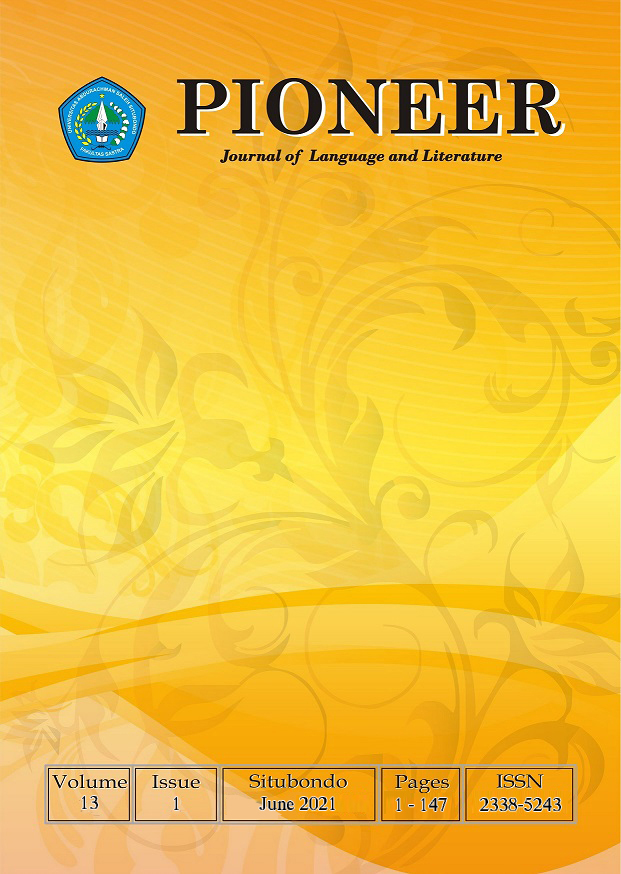A Multimodality Analysis
Construing Beauty Standard in Shampoo Advertisement
Abstract
Advertisement is a public media to promote a product or a service. Shampoo advertisements, especially the ones made for women, always show the advantages that the product gives to the customers. This study construed beauty standard in shampoo advertisements through the visual and linguistic elements, and found the differences in how they construe the beauty standard. This study used four different brands taken from Cosmopolitan magazine from 2016 to 2018. The brands are Love, Beauty and Planet, Loreal Extraordinary Oil, Treseme and Garnier Fructis. This study used the Multimodality approach using two modes, visual and linguistic elements. This study used Generic Structure Potential by Cheong (2004) to divide the linguistic and visual elements, then used Kress and Leeuwen's visual grammar to analyze the visual element (2006) and used Halliday's metafunction to analyze the linguistic elements (1978). Then this study analyzed the interplay of the visual and linguistic elements to construe beauty standards in society using O'Halloran SF-MDA (2008). The study shows that all of the shampoo advertisements have different ways to construe beauty standard in society through the visual and linguistic elements.
Downloads
References
Butt, D., Fahey, R., Feez, S., Spinks, S., & Yallop, C. (2000). Using Functional Grammar: An Explorer’s Guide. Sydney, N.S.W: National Centre for English Language Teaching and Research.
Cheong, Y. Y. (2004). The construal of ideational meaning in print advertisement. Multimodal Discourse Analysis: Systemic-Functional Perspectives, In K. L. O’Halloran (Ed.), Multimodal discourse analysis: Systemicfunctional perspectives. London and New York: Continuum (pp. 163-195)
Dyer, G. (1982). Advertising as communication. London: Methuen.
Goddard, A. (1998). The language of advertising: Written texts. London: Routledge.
Grammer, K., Fink, B., Møller, A. P., & Thornhill, R. (2003). Darwinian aesthetics: sexual selection and the biology of beauty - GRAMMER - 2007 - Biological Reviews - Wiley Online Library. Biological Reviews, 385–407. http://onlinelibrary.wiley.com/doi/10.1017/S1464793102006085/abstract
Halliday, M. A. K. (1978). Language as social semiotic: The social interpretation of language and meaning. London: Edward Arnold.
Jewitt, C. (2001). Multimodal teaching and learning : the rhetorics of the science classroom. In Advances in applied linguistics.
Kress, G. (2011). The Routledge Handbook of Discourse Analysis Multimodal discourse analysis. May. https://doi.org/10.4324/9780203809068.ch3
Kress, G., & Leeuwen, T. van. (2006). Reading images: The grammar of visual design. London: Routledge.
Neuman, W. L. (2002). Social Research Methods: Qualitative and Quantitative Approaches. In Teaching Sociology (Vol. 30, Issue 3). https://doi.org/10.2307/3211488
Ningsih, E. F., Tallapessy, A., & Setiarini, R. (2014). Construing Ideational Meaning in Electronics Devices Advertisement in Jawa Pos: A Systemic Functional Linguistic Multimodal Discourse Analysis. 2(1).
O’Halloran, K. L. (2008). Systemic functional-multimodal discourse analysis (SF-MDA): Constructing ideational meaning using language and visual imagery. Visual Communication 7 (4) : 443-475. ScholarBank@NUS Repository. https://doi.org/10.1177/1470357208096210
Sarwer, D. B., Grossbart, T. A., & Didie, E. R. (2003). Beauty and society. Seminars in Cutaneous Medicine and Surgery, 22(2), 79–92. https://doi.org/10.1053/sder.2003.50014
Silverman, D. (2016). Doing qualitative research: A practical handbook. London: Sage Publications.
Wang, J., Dai, Y., & Jiang, L. (2014). Multimodal discourse analysis of interactive meaning of food advertisement printed in English. Carpathian Journal of Food Science and Technology, 6(2), 9–15.
An author who publishes in Pioneer: Journal of Language and Literature agrees to the following terms:
- Author retains the copyright and grants the journal the right of first publication of the work simultaneously licensed under the Creative Commons Attribution-ShareAlike 4.0 License that allows others to share the work with an acknowledgement of the work's authorship and initial publication in this journal
- Author is able to enter into separate, additional contractual arrangements for the non-exclusive distribution of the journal's published version of the work (e.g., post it to an institutional repository or publish it in a book) with the acknowledgement of its initial publication in this journal.
- Author is permitted and encouraged to post his/her work online (e.g., in institutional repositories or on their website) prior to and during the submission process, as it can lead to productive exchanges, as well as earlier and greater citation of the published work (See The Effect of Open Access).

























